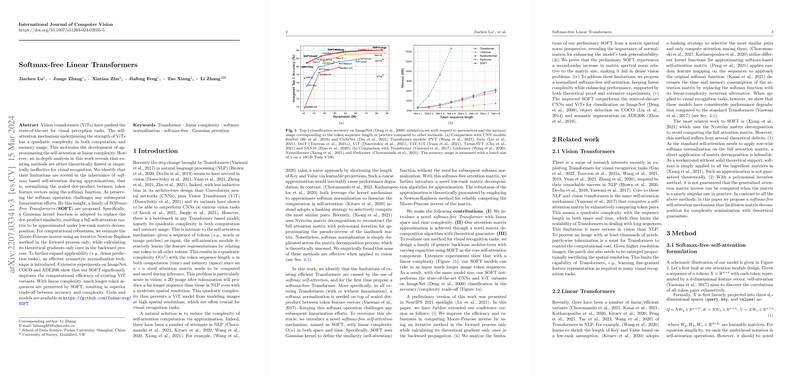Softmax-Free Linear Transformers
The paper "Softmax-free Linear Transformers," authored by Jiachen Lu et al., addresses a notable challenge in the current trajectory of Vision Transformers (ViTs), specifically the quadratic complexity inherent in computation and memory usage due to the self-attention mechanism's reliance on softmax. The authors propose a novel approach that circumvents this complexity by removing the softmax normalization, proposing a family of Softmax-Free Transformers (SOFT).
Key Insights and Contributions
The authors identify significant theoretical and empirical limitations in existing methods aimed at approximating self-attention with linear complexity. The dependency on softmax for normalizing the scaled dot-product between tokens is highlighted as a core issue. In this context, the authors present SOFT, a range of models employing a Gaussian kernel function in lieu of the conventional dot-product similarity. This substitution enables a comprehensive self-attention matrix approximation leveraging low-rank matrix decomposition.
Notably, the computational robustness of the proposed method is fortified through the estimation of the Moore-Penrose inverse using an iterative Newton-Raphson process during the forward phase. This innovative approach significantly improves computational efficiency for ViT variants, allowing longer token sequences with linear complexity while optimizing the trade-off between accuracy and complexity.
Numerical Results and Empirical Validation
The extensive experimental evaluation of SOFT models on benchmarks such as ImageNet, COCO, and ADE20K demonstrates substantial improvements in computational efficiency and model accuracy compared to existing ViT variants. Numerical results illustrate that SOFT models not only accommodate longer image token sequences but also outperform state-of-the-art both CNNs and ViTs across several visual recognition tasks. Figures presented in the paper, such as comparisons of top-1 classification accuracies and memory usage, substantiate these claims.
Implications and Future Directions
This research offers both practical and theoretical advancements in the domain of ViTs. The intrinsic design of softmax-free self-attention, underscored by Gaussian kernel application, mitigates the traditional limitations posed by softmax normalization in linearizing transformer complexity. This innovation has profound implications for the scalability of ViT architectures, particularly when tackling high-resolution visual inputs.
Theoretically, the paper paves the way for new explorations in kernel-based attention mechanisms within transformers, presenting an opportunity to further refine and optimize the computational paradigms underpinning large-scale vision models. The iterative estimation technique's deployment, albeit effective, introduces a prospective exploration into newer, more computationally intelligent algorithms for matrix inversion. Moreover, the asymmetric trade-offs in training speed versus inference gain observed in SOFT variants suggest fruitful investigations into parallel and distributed computing approaches tailored for these models.
The future of AI, particularly in the domain of image-based recognition, holds promise as the hardware and algorithmic components continue to evolve. Integrating SOFT mechanisms potentially broadens the accessibility of high-throughput, accuracy-intensive models to platforms otherwise constrained by hardware limitations, representing a substantial leap toward real-time, resource-efficient visual recognition systems.
In conclusion, the contribution of "Softmax-free Linear Transformers" is both timely and invaluable, offering a distinct pathway for overcoming inherent transformer limitations through innovative softmax-free attention mechanisms and establishing a robust foundation for future developments in the field.
